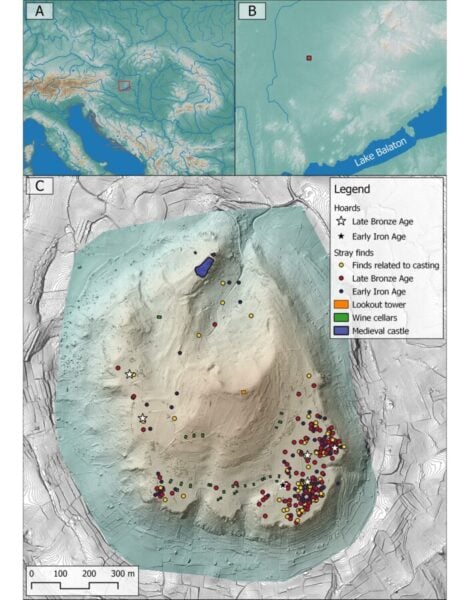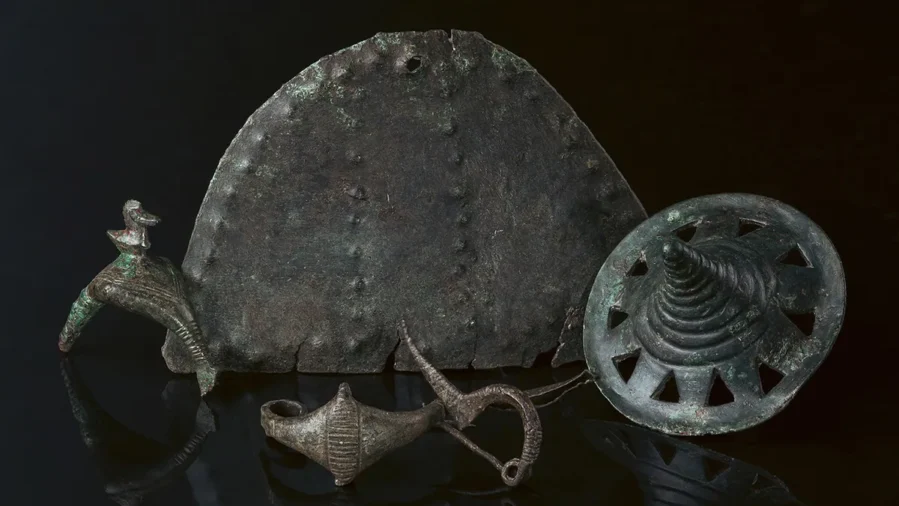Archaeologists have uncovered six remarkable metal hoards dating back over 3,000 years at Somló Hill in western Hungary, providing unprecedented insight into Late Bronze Age and Early Iron Age communities that once thrived on this prominent volcanic butte.
A multidisciplinary research team from the National Institute of Archaeology of the Hungarian National Museum Public Collection Centre initiated systematic investigations of this untouched hilltop in early 2023, revealing evidence of continuous occupation from approximately 1400-450 BC along with sophisticated metalworking and ritual practices.
Technology Unveils Hidden Archaeological Landscape
Using a combination of advanced technologies including metal-detector surveys, airborne laser scanning, and magnetic surveys, researchers have documented over 300 ancient metal artifacts scattered across the hilltop’s 431-meter peak. The most significant concentration appears on the southeastern plateau, suggesting this was a central area of activity.
LIDAR scanning produced detailed digital terrain models revealing previously unidentified features despite centuries of viticulture that modified the landscape. These include possible prehistoric pathways and terraces that had remained undetected until now.
Unique Opportunity to Study Ancient Depositional Practices
What makes the Somló Hill discoveries particularly valuable to archaeologists is the meticulous documentation of the hoards’ excavation using photogrammetry and video recording. This detailed approach offers researchers an unparalleled opportunity to understand how Bronze Age people arranged and deposited valuable items – information typically lost in earlier discoveries.

The six hoards – five from the Late Bronze Age and one from the Early Iron Age – contain surprising elements beyond metal objects:
- Amber beads suggesting long-distance trade connections
- Boar and domestic pig tusks indicating ritual significance
- Fabric and leather components rarely preserved in archaeological contexts
- Ceramic vessels containing intact assemblages of bronze items
- Evidence of deliberate fragmentation patterns of metal objects
Advanced Scientific Analysis Reveals Hidden Details
Two hoards discovered inside ceramic vessels were extracted intact and subjected to computed tomography at the University of Pannonia, allowing researchers to examine the precise arrangement of items within the containers without disturbing them – a first for Hungarian archaeology.
How might these ritual deposits relate to the daily lives of the hilltop’s ancient inhabitants? This question drives the researchers’ next phase of investigation, which will focus on understanding whether these precious assemblages were buried within settlements or in specially designated areas.
A particularly impressive find – an elaborate Alpine-style spearhead – underwent neutron tomography to identify specific production techniques and defects, potentially revealing information about ancient metalworking technology and craft specialization.
Evidence of Advanced Agricultural Practices
Archaeobotanical analysis conducted on sediment samples from one hoard revealed small-seeded lentils, cereal fragments, and what appears to be broomcorn millet. These plant remains provide valuable insights into the dietary practices and agricultural capabilities of the region’s Late Bronze Age communities.
Rewriting Regional Bronze Age Chronology
The discoveries at Somló Hill are particularly significant because they fill critical gaps in archaeological knowledge. Hoards from this specific period (Hallstatt B1 and B2, approximately 1080-900 BC) are exceptionally rare in Hungary’s Transdanubia region and typically lack secure archaeological contexts.
Perhaps most surprisingly, the research has revealed that occupation of the hilltop continued uninterrupted during the transition from the Late Bronze Age to the Early Iron Age – challenging previous assumptions about settlement patterns during this pivotal period of European prehistory.
Future excavations will focus on clarifying the absolute chronology of the site through radiocarbon dating of zooarchaeological material associated with the hoards – potentially providing more precise dating for this transitional period than was previously possible.
The ongoing research project, supported by the National Archaeological Institute of the Hungarian National Museum, promises to continue yielding valuable insights into this significant prehistoric center and its role within the wider settlement network of ancient Central Europe.
If our reporting has informed or inspired you, please consider making a donation. Every contribution, no matter the size, empowers us to continue delivering accurate, engaging, and trustworthy science and medical news. Independent journalism requires time, effort, and resources—your support ensures we can keep uncovering the stories that matter most to you.
Join us in making knowledge accessible and impactful. Thank you for standing with us!

